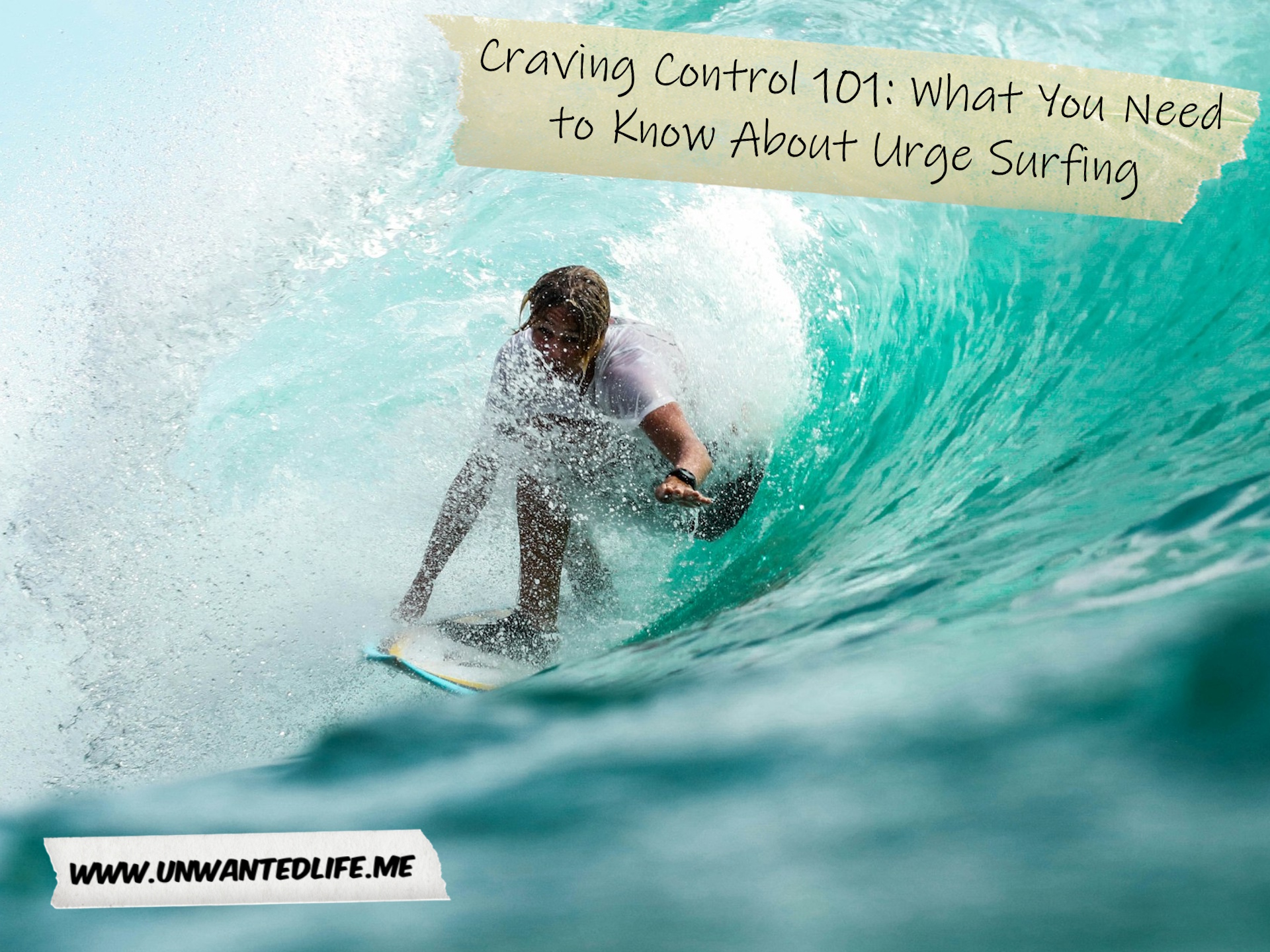I was first introduced to urge surfing while volunteering for a substance dependency charity, and I liked the concept. Fast forward a lot of years, and I wondered if this approach could be used in other areas of our lives, and it turns out it could. Hence, this article.
What Are Cravings And Urges?
According to the non-profit organisation, The Mungo Foundation (n.d.), a craving can be seen as a desire to want to enjoy the positive effect of something, such as alcohol, or be triggered by a stimulus, such as a thought, a bodily sensation, or an object. Whereas an urge is our impulse to satisfy that craving.
Urges aren’t just limited to cravings and addiction. Some people with autism spectrum disorder (ASD) engage in verbal and physical aggression, where they can struggle to manage the urge to act that way (Singh et al., 2019). But that isn’t exclusive to people with ASD, many people struggle with managing their anger.
What Is Urge Surfing?
One thing I know I struggle with, and I’m sure many of you probably do or have at some point, is controlling my urges. It’s not like I give in to every urge; if I did, I would be either in prison or a specialist hospital.
There are certain urges I’m a sucker to giving into, while other times I’m extremely disciplined with. For example, when I used to enjoy recreational drugs, I always had one rule: never chase a high. A rule I manage to stick to. But when it comes to chocolate, 99% of the time, I’m giving in to that urge. Strange, isn’t it?
Urge control is one of the things that gets in our way, stopping us from being as healthy as we could or as productive as we’d like to be (Lloyd, 2003). Something I need to work on for sure.
When we experience an urge, it can often feel like an itch that we need to scratch. Some of us may be able to hold out until it passes, but usually, we focus on the urge. Ideally, it’d be better to accept the urge with non-judgment and compassion to see how long it takes to pass (Rayner and Wright, 2024).
According to Lloyd (2003), urge surfing has been shown to be an effective intervention when taught as part of cognitive behavioural therapy (CBT), helping people resist urges and temptations. Urges like retail therapy, promiscuity, and even self-harm (Rayner and Wright, 2024).
Imagine an urge as a wave. It builds in intensity, peaks, and then naturally subsides. Urge surfing teaches us to observe this process, rather than fight it or give in to it. These waves may grow in intensity, but they will eventually subside. Yes, urges will go away on their own. However, if we give in to them, then we’re making those urges stronger (Lloyd, 2003).
Rayner and Wright (2024) stated that an urge usually passes in 20-30 minutes, which seems like a lot, because it is. But if we don’t fight the urge and do that without being self-critical, it’ll be a little less of an unpleasant experience. Any negative, intrusive thoughts or activity from our inner critic will also pass.
There are basically two options when we experience an urge and don’t want to give in to it, according to Prance (2019). Option one is to fight the wave (urge), but as King Canute demonstrated, not even a king has control over the elements. Option two is to ride the wave, and in this sense, we ride the wave to the shore, where it’ll be safe and calm.
Simply put, fighting an urge can be like throwing fuel on a fire; it’s only going to get stronger. Unless you’re like me, trying to maintain a campfire, then it dies.
In a nutshell. Urge surfing is a mindfulness technique that, while often used in the treatment of addiction, has valuable applications far beyond that specific context. Essentially, it’s about observing and riding out intense feelings or impulses without acting on them.
By observing rather than reacting, urge surfing empowers us to respond intentionally instead of impulsively, helping us to build resilience, improve decision-making, and overall wellbeing. And, once the urge has passed, carry on with our intended behaviour.
How Can Urge Surfing Help
Anxiety management
When anxiety arises, it often creates a strong urge to escape or avoid whatever triggers our anxiety. Urge surfing helps us sit with the anxiety, observe its physical and mental sensations, and allow it to pass. By observing our anxious thoughts and physical tension without immediate reaction, we let the feelings rise and fall like a wave. This combination of urge surfing and exposure therapy would work really well together.
Emotional regulation
The technique of urge surfing can be used to manage any intense emotion, such as anger (Singh et al., 2019), frustration, or sadness. Instead of reacting impulsively, we learn to observe the emotions’ ebb and flow. Therefore, if we’re feeling angry, instead of reacting impulsively, urge surfing helps us to acknowledge the emotion, notice how it feels in the body, and allow it to pass.
Teaching people with ASD who may struggle with managing their anger urge surfing as an intervention has been shown to be effective in a study by Singh et al. (2019). In this study, the self-management skill of urge surfing was taught to three adolescents with ASD. They were taught to think of their breath as a surfboard to ride their waves of anger without giving in to the urge to be aggressive.
Although this study used a very small sample size, all three showed clinically and statistically significant changes in their anger. So much so that they were able to discontinue the use of prescribed psychotropic medication. Thus, providing proof-of-concept for the effectiveness of urge surfing.
Impulse control
Whether it’s the urge to overspend, overeat, or engage in any other impulsive behaviour, urge surfing provides a tool to pause and observe the impulse before acting. For example, when it comes to comfort eating, urge surfing can help with food cravings by noticing hunger or desire without acting on it.
When it comes to procrastination, rather than giving in to the urge to avoid work, urge surfing allows us to sit with discomfort and stay productive. With overspending, acknowledging the urge to make impulsive purchases helps reduce compulsive spending, which will hopefully help control our retail therapy habits.
Stress management
In stressful situations, we often have the urge to react immediately. Urge surfing helps us create a space between the urge and the response, allowing for more thoughtful action.
Habit change
Any unwanted habit, from nail-biting to procrastination, can be addressed with urge surfing. This is exactly why I learnt about this while working in the field of addiction. It helps us become aware of the triggers and the urges that lead to the behaviours we want to change, allowing us to choose a different response. Couple this with a stop-doing list, and we should have a winning formula.
Daily life applications
Here are a few daily life examples, but there are so many more. If we feel we have an issue with our use of social media, causing us to mindlessly doomscroll, urge surfing can prevent this by encouraging us to pause and observe the impulse to check our phone.
An important part of a healthy social support network is how we manage interpersonal conflict. Therefore, before reacting in an argument, urge surfing helps us pause, reflect, and respond calmly. Lastly, for the examples, if we’re experiencing physical discomfort, such as during exercise, urge surfing allows us to tolerate temporary discomfort.
How To Do Urge Surfing
There are four basic steps to urge surfing (Lloyd, 2003), which are:
- Knowing what urge surfing is. Check.
- Assessing our high-risk urge situations, which really shows its addiction roots. But still applies. For example, if we’ve had a long day, we may be tempted to order a takeaway instead of cooking. Knowing this will help us manage our urges when they happen.
- Develop a clear understanding of how we experience our urges. Cracking open a journal and describing how we experience our urges can be a great little exercise for this.
- Challenge any irrational beliefs or assumptions that may occur during our urges, as we’ve just written about it in the above journaling exercise.
According to Singh et al. (2019), when we feel the urge waves coming, instead of engaging with them, we switch our attention to our breath, using it like a surfboard to ride the waves. Simply observe the urge with an open, calm, non-judgmental, and curious mind. This may cause a slight increase in the urge waves at first, but repeated engagement in urge surfing will help overcome the urge, and maybe even rid us of that urge.
Try the following activity as outlined by Rayner and Wright (2024):
- Find something that’s soft and ticklish, such as a feather or something soft.
- With the ticklish item, tickle our hand with it.
- As we do this, think about our urge to scratch our hand or to stop this activity, but don’t stop.
- Try to notice the sensations in a compassionate and mindful way using all our senses.
- Notice how these sensations change over time if we don’t scratch or stop the activity.
- Think about what’s causing these sensations to change.
- Remember to focus on our breath to ride the wave like we’re on a surfboard.
- After you’ve done this for a few minutes, reflect on this activity and write about what happened to the urge, how strong the urge was to scratch your hand or to stop tickling yourself, and what this urge surfing exercise was like.

Key Principles
Mindful observation
Pay attention to the physical and mental sensations associated with the urge.
Non-judgmental acceptance
Acknowledge the urge without labelling it as being “good” or “bad”, it’s a bodily function. One that can be mastered with practice, patience, and kindness.
Riding the wave
Allow the urge to pass naturally, without trying to suppress it. Suppression often has the opposite effect to what we intended.
Patience
Understand that urges are temporary and will eventually subside. So we need to treat ourselves with kindness as we learn to master our urges with urge surfing.
Summary
Urge surfing is a valuable tool for developing greater self-awareness and control over our impulses and emotions. It empowers us to respond to life’s challenges with more mindfulness and less reactivity. Thus, urge surfing can be a helpful tool for managing a variety of unwanted behaviours, including addictions, compulsive behaviours, and emotional eating. It can also be used to manage difficult emotions, such as anger or anxiety.
Remember, urge surfing is not about suppressing or eliminating urges. It’s about learning to observe them without judgment and making conscious choices about how to respond. By practising urge surfing, we can develop greater self-awareness and self-control and ultimately improve our quality of life.
It’s also useful to know that we’re more likely to give in to our urges when we’re not in a good place regarding our mental wellbeing (Lloyd, 2003). That could be because of stress or because we’ve not been engaging in self-care on a regular basis. So, if we want to avoid urges being a problem, make time for your hobbies and other interests. Our mental resilience depends on it.
As always, leave your feedback in the comments section below. Also, please share your experiences with cravings and urge surfing in the comments section below. Don’t forget, if you want to stay up-to-date with my blog, you can sign up for my newsletter below. Alternatively, click the red bell icon in the bottom right corner to get push notifications for new articles.
Lastly, if you’d like to support my blog, please find the PayPal and Ko-fi donation payment options below. Until next time, Unwanted Life readers.
References
Lloyd, A. (2003). Urge surfing. In W. O’Donohue, J. E. Fisher, & S. C. Hayes (Eds.), Cognitive behavior therapy: Applying empirically supported techniques in your practice (pp. 451-455). John Wiley & Sons. Retrieved from https://www.academia.edu/download/34013534/COGNITIVE_BEHAVIOR_THERAPY__App_-_William_ODonohue__Jane_E._Fish.pdf#page=471.
Prance, K. (2019, December). Urge Surfing – What is it?. Rehab Recovery. Retrieved from https://www.rehab-recovery.co.uk/resources/urge-surfing-what-is-it.
Rayner, G., & Wright, K. (2024). Compassionate care for people who self-harm: principles, tools and techniques. Mental Health Practice, 27(6). Retrieved from https://clok.uclan.ac.uk/45103/1/V2%20Compassion%20Focussed%20Nursing%20with%20people%20who%20self%20harm.pdf.
Singh, N. N., Lancioni, G. E., Karazsia, B. T., Myers, R. E., Kim, E., Chan, J., Jackmang, M. M., McPherson, C. L., & Janson, M. (2019). Surfing the urge: An informal mindfulness practice for the self-management of aggression by adolescents with autism spectrum disorder. Journal of Contextual Behavioral Science, 12, 170-177. Retrieved from https://www.researchgate.net/profile/Jeffrey-Chan-4/publication/328544376_Surfing_the_Urge_An_Informal_Mindfulness_Practice_for_the_Self-Management_of_Aggression_by_Adolescents_with_Autism_Spectrum_Disorder/links/5c5bd2a4299bf1d14cb1a24e/Surfing-the-Urge-An-Informal-Mindfulness-Practice-for-the-Self-Management-of-Aggression-by-Adolescents-with-Autism-Spectrum-Disorder.pdf.
The Mungo Foundation. (n.d.). Cravings & Urges. The Mungo Foundation. Retrieved from https://www.themungofoundation.org.uk/wp-content/uploads/2021/03/3-Difference-betweeen-Cravings-Urges.pdf.









